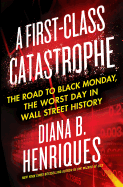
Reading Diana B. Henriques's A First-Class Catastrophe: The Road to Black Monday, the Worst Day in Wall Street History could be a revelation to younger readers used to thinking of the 2008 financial crisis as the signature market crash of modern times. Henriques brings readers' attention back to October 19, 1987--dubbed "Black Monday"--when the Dow Jones Industrial Average dropped a shocking 22.6%, "still the largest one-day decline in Wall Street history. That was the equivalent of an urgent midafternoon news flash today screaming, 'DOW FALLS NEARLY 5,000 POINTS!' " The book is a reminder that the 2008 meltdown was not unprecedented, and that the disaster might have been avoided altogether if market leaders and government officials had learned the right lessons from the 1987 crash.
Henriques has a low-key style, favoring patient explanation over moral outrage. Still, her account subtly undermines the concept of rational markets while also making the case for pragmatic responses to financial crises. Referring to the controversial question of whether to bail out big banks while letting smaller ones fail, Henriques writes: "If a bunch of small retention ponds are leaking and there is a rapidly growing crack in the Hoover Dam, you shore up the Hoover Dam." Her account is not hopeful, as might be expected from a book about a major crisis that "if it was remembered at all, was recalled as the crash without consequences." A First-Class Catastrophe capably punctures that myth, along with many more dangerous truisms that continue to proliferate in political and financial circles. --Hank Stephenson, bookseller, Flyleaf Books, Chapel Hill, N.C.

